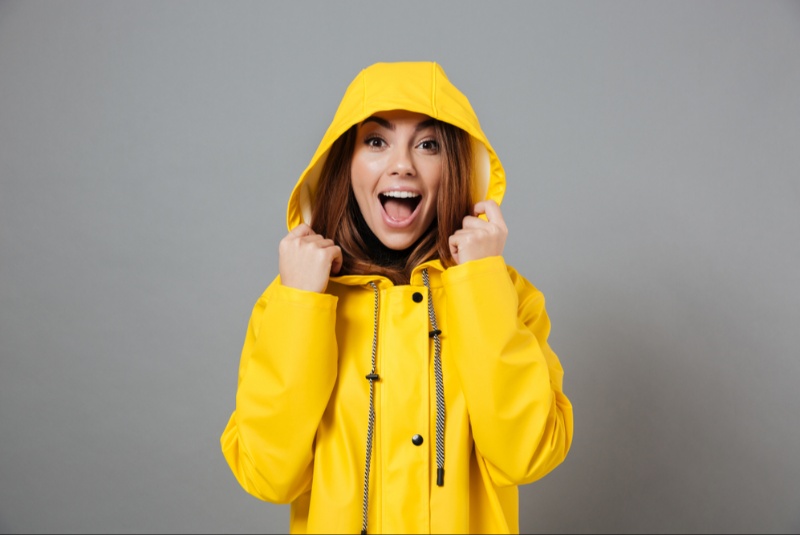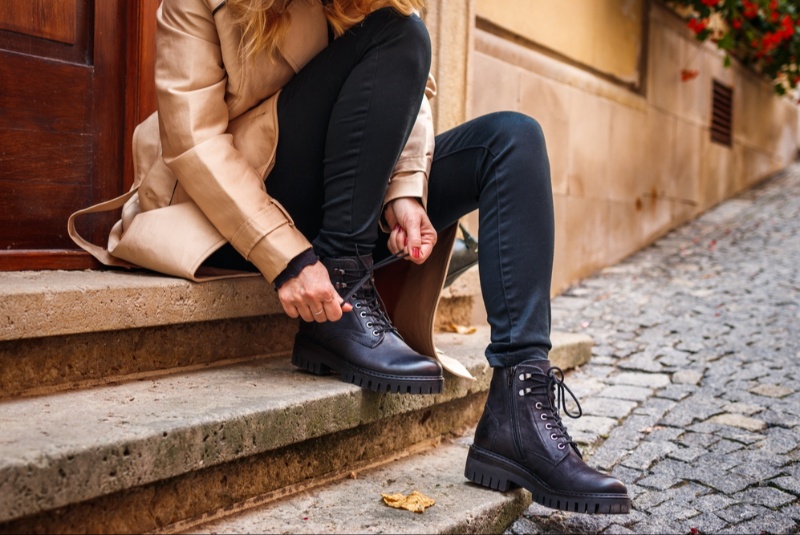The search for a reliable raincoat goes beyond mere practicality; it’s an investment in comfort, style, and durability. In today’s fashion landscape, where sustainable and enduring choices are valued, selecting a raincoat that stands the test of time has become more important than ever. This guide will explore essential factors to consider when choosing a raincoat that is both fashionable and built to last, ensuring your purchase is a valuable and versatile addition to your wardrobe.
1. Material Matters: The Foundation of Durability
The durability of a raincoat largely depends on the material used in its construction. Traditional materials, such as rubberized cotton and vinyl, have long been used for rainwear, each with specific benefits and limitations. More recently, advancements in synthetic fabrics, like Gore-Tex and eVent, have offered a balance of lightweight comfort and durability.
- Rubberized Cotton: Known for its resilience and traditional look, rubberized cotton provides an effective barrier against rain. Its primary drawback is weight; rubberized cotton raincoats can be heavier and less breathable, making them less ideal for intense activity or warmer climates.
- Vinyl: Often used for lightweight rain jackets, vinyl is waterproof and easy to clean. However, it tends to be less durable over time and may lack breathability, which could lead to discomfort in humid conditions.
- Advanced Synthetics: Modern fabrics like Gore-Tex, eVent, and other proprietary waterproof-breathable materials offer excellent durability, are lightweight, and allow airflow. These materials tend to be more expensive, but their high-performance qualities make them suitable for active and long-term wear.
Choosing the right material is essential for ensuring that your raincoat serves its purpose while being comfortable and durable enough for long-term use. When considering materials, think about the typical weather conditions in your area, your intended use, and how often you plan to wear the raincoat.
2. Construction Quality: The Blueprint of Endurance
While material selection is crucial, construction quality is equally important. Pay attention to how the raincoat is assembled. **Taped or welded seams** are generally more durable and waterproof, as they prevent water from seeping through the stitching. Additionally, high-quality zippers and closures contribute to the overall durability of the raincoat. Look for water-resistant or waterproof zippers, which are more effective at keeping rain out compared to standard zippers.
Buttons, drawstrings, and closures should also be made from high-quality materials. Reinforced stitching at key stress points, like the shoulders and pockets, adds to the coat’s durability. Investing in a raincoat with superior construction ensures you’re buying a piece that can handle the elements while maintaining its integrity over time.
3. Design and Fit: Marrying Comfort with Style
A raincoat should not only be durable but also stylish and comfortable. **Design and fit** play a significant role in ensuring your raincoat remains a go-to piece in your wardrobe. A well-fitting raincoat prevents excessive wear and tear from pulling and stretching. Look for a style that provides freedom of movement while maintaining a streamlined silhouette.
Consider the overall look as well; raincoats come in various styles, from trench coats to parkas to more utilitarian jackets. Choose a style that complements your existing wardrobe and aligns with your aesthetic preferences. A good design doesn’t just look better; it performs better, keeping you comfortable and protected in rainy weather.
4. Breathability: The Comfort Factor
Keeping rain out is essential, but so is allowing moisture from sweat to escape. **Breathability** is particularly important if you plan on using your raincoat for outdoor activities or in warmer climates. Advanced materials, like Gore-Tex and eVent, provide a balance of waterproofing and breathability. Some coats feature ventilation zippers or mesh linings, which add another layer of comfort by improving airflow.
When shopping, look for raincoats specifically labeled as breathable. While these coats tend to be more expensive, the added comfort and versatility they provide can be worth the investment, especially for active users or those who wear their raincoat frequently.

5. Waterproof Rating: Understanding the Specifications
Raincoats often come with a **waterproof rating**, measured in millimeters (mm), indicating how much water pressure the fabric can withstand. A higher rating generally reflects better waterproofing. For instance, a rating of **5,000mm** offers adequate protection for light rain, while **10,000-20,000mm** ratings are more suitable for heavy rain and harsh conditions.
Understanding these ratings helps in selecting a raincoat that aligns with the weather conditions you’ll encounter most often. If you live in an area with frequent, heavy rainfall, investing in a raincoat with a high waterproof rating may be worthwhile. Conversely, for occasional or light rain, a lower rating might suffice, keeping your coat lightweight and comfortable.
6. Brand Reputation and Warranties: The Assurance of Quality
Opting for a brand with a strong reputation for quality and reliability can be an excellent way to ensure you’re buying a durable raincoat. Many reputable brands offer warranties or guarantees on their rainwear, which is a testament to the product’s durability. Brands like **Columbia, The North Face, and Patagonia** are known for producing high-quality outerwear and often include warranties on their products.
Reading reviews and seeking recommendations can also provide insights into a brand’s reliability. A solid warranty or customer service policy adds peace of mind, knowing that the brand stands behind the quality of its products.
7. Care and Maintenance: Prolonging Your Raincoat’s Life
To ensure your raincoat lasts, proper care and maintenance are essential. Follow the care instructions provided by the manufacturer, as different materials require different approaches. Regular cleaning keeps the raincoat’s waterproof qualities intact and prevents the build-up of dirt and oils, which can degrade materials over time.
Occasionally, some raincoats benefit from re-waterproofing treatments. Waterproofing sprays or treatments can revive a raincoat’s resistance to water, particularly for fabrics like Gore-Tex. Proper drying is also crucial—avoid high heat, as it can damage certain materials. Instead, hang the coat to dry naturally.
8. Environmental Considerations: A Sustainable Choice
With growing environmental awareness, many consumers seek eco-friendly options in rainwear. Sustainable raincoats are often made from recycled or renewable materials, reducing environmental impact. Some brands now offer raincoats crafted from **recycled polyester** or **PFC-free waterproofing treatments**.
Eco-friendly raincoats not only support environmental goals but also tend to emphasize quality and durability, aligning with sustainable practices. Look for certifications or statements from brands that confirm their commitment to sustainable practices. Choosing a raincoat with eco-conscious materials adds another layer of value to your purchase, knowing it’s a responsible choice for the planet.
9. Versatility: Beyond Just Rain Protection
Consider how versatile the raincoat is beyond its primary function. A good raincoat can double as a windbreaker or outer layer in cooler weather, adding to its practicality. Some raincoats offer **removable liners** or are designed for year-round wear, providing value beyond wet weather protection.
Look for features that make the coat adaptable to various conditions and settings. A versatile raincoat allows you to use it in different seasons and situations, providing better value and making it a reliable piece in your wardrobe.
10. Budget: Balancing Cost and Quality
Finally, consider your budget. While premium raincoats can offer superior durability and features, there are durable options available at various price points. Quality raincoats are an investment, but finding the right balance between cost and functionality is key. For frequent wearers or those in rainy climates, spending a bit more for a durable raincoat is often worth it. Occasional users, however, may find mid-range options sufficient.
By balancing your budget with your specific needs and preferences, you can find a raincoat that meets your requirements without overspending.
Conclusion: Making a Lasting Choice
Selecting a long-lasting raincoat is a decision that encompasses material choice, construction quality, design, breathability, waterproof rating, brand reputation, care, environmental impact, versatility, and budget. With thoughtful consideration, you can invest in a raincoat that not only keeps you dry but also stands as a statement of timeless style and sustainability.
A well-chosen raincoat goes beyond mere practicality; it reflects a commitment to quality and conscious fashion. Whether facing a downpour or adding a stylish layer, your raincoat will be a valuable companion for years to come, enhancing both comfort and confidence in your wardrobe.




